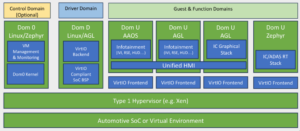
![]() Ryan Daws is a senior editor at TechForge Media with over a decade of experience in crafting compelling narratives and making complex topics accessible. His articles and interviews with industry leaders have earned him recognition as a key influencer by organisations like Onalytica. Under his leadership, publications have been praised by analyst firms such as Forrester for their excellence and performance. Connect with him on X (@gadget_ry), Bluesky (@gadgetry.bsky.social), and/or Mastodon (@gadgetry@techhub.social)
Ryan Daws is a senior editor at TechForge Media with over a decade of experience in crafting compelling narratives and making complex topics accessible. His articles and interviews with industry leaders have earned him recognition as a key influencer by organisations like Onalytica. Under his leadership, publications have been praised by analyst firms such as Forrester for their excellence and performance. Connect with him on X (@gadget_ry), Bluesky (@gadgetry.bsky.social), and/or Mastodon (@gadgetry@techhub.social)
Foxconn believes it can ease the projected shortfall of over four million nurses by 2030 with healthcare solutions like AI robot Nurabot.
Nurabot is a collaborative nursing robot, or ‘cobot’, designed to shoulder the burden of time-sapping and physically tiring jobs like ferrying medication and samples around hospital wards.
The robot is just one piece of Foxconn’s smart hospital puzzle, a suite of innovations built on NVIDIA’s technologies and already being trialled by leading medical centres in Taiwan. We’re also talking about AI models to keep a closer eye on patient health and sophisticated digital twins – virtual replicas of entire hospital facilities – to help management teams nail down design and streamline planning.
The grand vision is to weave these applications together, transforming hospitals into intelligent hubs powered by NVIDIA’s physical AI, all built on a clever three-pronged computing strategy.
First, enormous AI models are trained and fine-tuned on dedicated supercomputers. Then, digital twins become the testing ground for planning, validation, and even robotic training. Finally, nimble edge computing systems allow for rapid AI decisionmaking right there on the robots and sensors scattered throughout the hospital.
Pioneering this shift are several prominent Taiwanese healthcare institutions, including Taichung Veterans General Hospital (TCVGH), Baishatun Tung Hospital – Mazu Hospital, and Cardinal Tien Hospital. They’re embracing Foxconn’s smart hospital solutions, not to replace clinicians, but to empower them in a bid to elevate patient care.
Shu-Fang Liu, Deputy Director of the nursing department at TCVGH, said: “Taiwan has a highly developed healthcare infrastructure with a strong push toward digital health transformation, creating the ideal environment for robotic integration.
“Robots are augmenting our capabilities so we can provide more focused, meaningful care.”
Powering smart hospitals: From cloud to clinic floor
Foxconn is leveraging its Honhai Super AI Computing Center 1, a facility boasting NVIDIA DGX systems, specifically to forge healthcare-focused AI models. These are delivered via Foxconn’s CoDoctor AI platform, itself supercharged by NVIDIA AI, and are already enhancing diagnostic accuracy and smoothing out clinical workflows for tasks as varied as retinal imaging, vital sign monitoring, arrhythmia detection, and cancer screening.
Clinicians in the radiology department at Tungs’ Taichung MetroHarbor Hospital are already using Foxconn’s CoDoctor AI platform for their daily medical imaging tasks.
Beyond these foundational models, Foxconn is also working with medical centres to integrate the NVIDIA AI Blueprint for video search and summarisation. This could include real-time video feeds analysed instantly to flag medical events to staff, or to generate concise visual summaries for hospital managers, improving both immediate response and long-term planning.
It’s not just about proprietary systems; Foxconn is also giving back to the wider community. They’ll be contributing CoroSegmentater, their AI model for coronary artery segmentation, to the MONAI open-source medical imaging platform. This initiative, spearheaded by NVIDIA and leading academic medical centres, will see the model – which relies on MONAI’s Auto3DSeg framework for 3D medical image segmentation – be used to bolster diagnostics, aid preoperative planning, and even improve how patients understand their own conditions.
Clinical teams will be able to visualise these complex segmentations in 3D and render hearts and vascular systems on NVIDIA OVX servers with NVIDIA Isaac for Healthcare—all built on the NVIDIA Omniverse platform. Foxconn has even used Omniverse to create a tool that can simulate how different drug treatments might affect breast cancer tumours.
But the simulation capability doesn’t stop at human biology. Foxconn is collaborating with TCVGH, Baishatun Tung Hospital – Mazu Hospital, and Cardinal Tien Hospital to simulate the very bricks and mortar of their healthcare facilities using Omniverse. These physically-precise digital twins are invaluable, allowing hospitals to plan new builds, make data-backed decisions to finetune operations, and create realistic training environments for their robotic assistants.
TCVGH, for instance, has built a digital replica of one of its nursing stations and wards. This virtual space acts as a safe and effective training ground for Nurabot, letting the robot learn to navigate complex corridors and anticipate obstacles before it ever wheels onto the actual ward.
Nurabot on the ward
Now, let’s look closer at Nurabot itself. Co-developed by Foxconn and Japanese industrial giant Kawasaki Heavy Industries, the robot is sophisticated blend of the FoxBrain LLM for natural interaction, virtual honing through Isaac for Healthcare, and rapid onboard processing thanks to the NVIDIA Holoscan sensor processing platform running on an NVIDIA Jetson Orin device.
Foxconn estimates that once Nurabot is fully integrated into clinical workflows – delivering medications, whisking away specimens for testing, and patrolling wards – it could slash nurses’ workloads by up to 30%.
“In one of our wards, we are using Nurabot to deliver wound care kits and health education materials to patient bedsides,” said Liu. “For nurses, having a robot assistant reduces physical fatigue, saving them multiple trips to supply rooms and allowing them to focus more on patients.”
During the busy visiting hours, Nurabot even helps guide patients and visitors, taking some of the administrative strain off frontline staff. And when night falls, and staffing levels are naturally lower, it’s hoped Nurabot can help pick up some of the slack to ensure continuous support.
Looking ahead, Liu envisions her robot colleagues soon conversing with patients in various languages, recognising individuals for more personalised care, and even assisting nurses with the physically demanding task of moving patients. With a robotic assistant like Nurabot, a patient that may require two or more nurses to move could be manageable for a single nurse.
Early signs are promising. The Nurabot trial at TCVGH is drawing praise from both nurses and patients alike. The hospital is so encouraged that it expects to deploy dozens of these robotic units to support its nursing team by the end of this year.
This isn’t just a niche experiment. The weight behind these developments was clear when NVIDIA’s own chief, Jensen Huang, spotlighted Foxconn’s healthcare innovations during his keynote at the recent COMPUTEX trade show in Taipei.
The fusion of AI and robotics has the potential to reshape healthcare delivery and shows how technology can be used to enhance the human touch rather than replace it.
(Image credit: TCVGH, Foxconn, Kawasaki Heavy Industries)
See also: 5GAA demos lifesaving NTN and V2X tech for connected cars


Want to learn about the IoT from industry leaders? Check out IoT Tech Expo taking place in Amsterdam, California, and London. The comprehensive event is co-located with other leading events including Cyber Security & Cloud Expo, AI & Big Data Expo, Intelligent Automation Conference, Edge Computing Expo, and Digital Transformation Week.
Explore other upcoming enterprise technology events and webinars powered by TechForge here.
Tags: ai, artificial intelligence, foxconn, health, healthcare, internet of things, iot, omniverse, robotics, robots




